|
|
| Vintage Hockey Autographs, Autographed Hockey Memorabilia, Page 2
|
|
|
| Frank
Boucher autographed photo and letter |
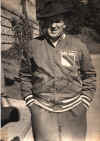
|
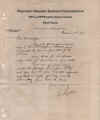
|
A very clever center who became an innovative coach, Boucher joined the Northwest Mounted Police at seventeen, then paid $50 to buy his way out so he could play professional hockey. He began his career
with Ottawa in 1921. After one season there, he played for the Vancouver Millionaires in the Pacific Coast Hockey League from 1922-23 through 1926-27, then joined the New York Rangers of the NHL. He was nicknamed "Raffles" after the gentleman thief in E. W. Hornung's stories because of his puck-stealing ability and his consistently clean play. Boucher won the Lady Byng Trophy, for combining sportsmanship with a high level of play, seven times in eight years, so the NHL finally gave it to him to keep
in 1935 and had a new one made. For much of his time with the Rangers, he
centered Bill Cook at right wing and Bill's brother Bun at left wing. Boucher led the NHL's American Division with 35 points in 1927-28 and was among the top ten scorers six other times. He retired after the 1937-38 season and became the Rangers' coach in 1939.
Boucher was the first coach to pull his goaltender for an extra
skater late in the game, and he developed the box defense for
killing penalties. He also taught his teams to attack when
short-handed; in 1939-40, when the Rangers won the Stanley Cup,
they scored almost twice as many goals on opponents' power plays
as the opposition did. In 1942, Boucher proposed adding the red
line to the hockey to speed up play. He later explained, "My
thought was that hockey had become a see-saw affair. Defending
teams were jammed in their own end for minutes because they
couldn't pass their way out against the new five-man attack." At
that time, teams weren't allowed to pass the puck out of the
defensive zone; when the red line was added for the 1943-44
season, the rule was changed to allow passing from behind the
blue line up to the red line.
Boucher made a brief comeback as a player in 1944, but gave it up
after fifteen games. He was replaced as the Rangers' coach during
the 1948-49 season, returned to the job in 1953, and retired for
good before the season was over.
Frank Boucher was one of the finest all-round players of his
time, his gentlemanly conduct on the ice served as a benchmark
for many who followed him. On February 9, 1962, Boucher was
presented the Sportsmanship Brotherhood's annual award in New
York. He was honored posthumously with the Lester Patrick Trophy
in 1993 for his immense contribution to the game in the United
States. A member of the Canadian Sports Hall of Fame and the
Ottawa Sports Hall of Fame, Boucher was elected to the Hockey
Hall of Fame in 1958.
|
| Lionel "The
Big Train" Conacher autographed 3 x 5 card, dated Nov. 11,
1933 |

|
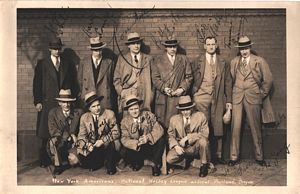
|
|
Lionel Conacher was a charter inductee in the Canadian Lacrosse Hall of Fame (1951), and has been inducted into the Canadian Football Hall of Fame (1963), the Hockey Hall of Fame (1994), and the
Canadian Sports Hall of Fame. His wrestling career never reached hall-of-fame status. As an amateur, Conacher won the Ontario championship in the 125 pound weight class as a 16 year old in 1916. After training with Ali Hassan, he made his pro debut in May 1932 for Toronto promoter Ivan Mickailoff. Conacher went 27-0 as a pro wrestler in Canada and the U.S. in 1933 and never lost a match in his career. In football, Conacher played for the Toronto Argonauts (1921-22) and won the Grey Cup in 1921. The previous year,
he had won hockey's Memorial Cup as a member of the Toronto Canoe Club Paddlers. Conacher went on to a 12-year career in the NHL (1925-37), mostly with the Montreal Maroons, where he was a
second-team all-star defenseman in 1932-33, and played on the Stanley Cup winning team of 1934-35. He first played on a Stanley Cup winner in his one season with the Chicago Black Hawks (1933-34), where Conacher was also a first-team all-star. As a hockey player, not only was Conacher a solid defenseman, he was also known for his fighting. He was among the penalty-minutes leaders, and even had a fight with his younger brother Charlie, a dominant goal scorer with the Maple Leafs. Conacher was a member of the Toronto
Maple Leaf baseball team that won the Triple-A championship in 1926. And, in addition to being one of the greatest lacrosse players in the country, he was also an undefeated light-heavyweight boxer (and fought an exhibition bout against Jack Dempsey in 1922). After retiring from sports, Conacher was elected as a member of the Liberal party to the Ontario legislature in 1937 and to the Canadian House of Commons in 1949. Conacher was voted Canada's Athlete of the Half Century by the Canadian Press in 1950. He died
in 1954, suffering a heart attack while playing in a softball game.
|
| Lord
Stanley of Preston, 16th Earl of Derby autographed paper
cut |

|
 |
|
The top
signature on this cut dinner program is of the Earl of Derby,
Lord Stanley of Preston. In 1893, Lord Stanley gave Canada a
treasured national icon -- the Stanley Cup. He originally donated
the trophy as an award for Canada's top-ranking amateur hockey
club. Then in 1926, the National Hockey League adopted the
Stanley Cup as the championship prize in professional hockey.
That this now famous cup bears Lord Stanley's name is a fitting
tribute to his encouragement and love of outdoor life and sport
in Canada. In recognition of this, Lord Stanley was inducted into
the Canadian Hockey Hall of Fame in 1945 in the "Honoured
Builders" category
|
| Lord Byng,
donator of the Lady Byng Memorial Trophy signed letter along with
a studio photo and Christmas card |
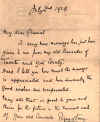 |

|
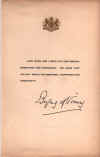
|
The above
letter was written by Lord Byng of Vimy on July 29, 1929. Lady Byng, wife of Canada's Governor-General Lord Byng,
presented the Lady Byng Trophy in 1925 to the National Hockey
League. After Frank Boucher of the New York Rangers won the award
seven times in eight seasons, he was given the trophy to keep and
Lady Byng donated another trophy in 1936. After Lady Byng's death
in 1949, the National Hockey League presented a new trophy,
changing the name to the Lady Byng Memorial Trophy.
The trophy is an annual award given to the player adjudged to
have exhibited the best type of sportsmanship and gentlemanly
conduct combined with a high standard of playing ability. The
winner is selected in a poll of the Professional Hockey Writers'
Association at the end of the regular season.
|
| Neil
Colville's New York Rangers contract, 1944-45
NHL season |
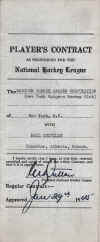
|
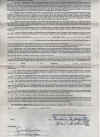
|
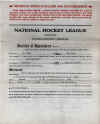
|
This NHL
contract is between the New York Rangers and future NHL Hall of
Famer Neil Colville for the 1945 hockey season. The contract
covers the period of January 20, 1945 through April 15, 1945.
Neil is to be paid the sum of $1.00 Dollar by
the New York Rangers! The contract is signed by Neil Colville
(HOF), Lester Patrick (HOF), Frank Boucher (HOF) and by League
president and HOF'er, Red Dutton.
Neil Colville played for the New York Rangers as a
Center/Defenseman from 1935 until 1949.
His NHL career stats are as follows:
464 Games played - 99 Goals - 166 assists.
NHL All-Star 1939, 1940 and 1948.
|
| Harry
Howell's New York Rangers contract, 1962-63
NHL season |
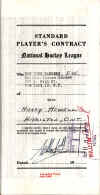 |
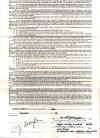 |
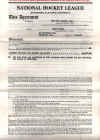 |
This NHL
contract is between the New York Rangers and NHL Hall of Famer
Harry Howell for the 1963 hockey season. The contract covers the
period of October 1, 1962 through the end of the season. Harry is
to be paid the sum of $18,500.00 by the New York Rangers. The
contract is signed by Harry Howell (HOF), Murray Patrick and by
League president and HOF'er, Clarence Campbell. Harry Howell
played for the New York Rangers, Oakland Seals and Los Angeles
Kings as a Defenseman from 1952 until 1973.
His NHL career stats are as follows:
1411 Games played - 94 Goals - 324 Assists.
NHL All-Star 1954, 1963, 1964, 1965, 1967, 1968 and 1970.
James Norris trophy winner 1967.
|
| Roy
"Shrimp" Worters autographed 1933-34 Ice Kings card & 1935-36 Triumph Postcard |
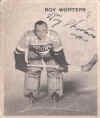
|
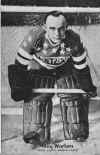
|
Despite his
5'3" frame, the aptly named "Shrimp" Worters seemed like a giant
to opposing shooters. He became one of the NHL's all-time great
goalkeepers, chalking up a phenomenal 66 shutouts in only 12
seasons. But because his tenure was chiefly with the Pittsburgh
Pirates and New York Americans, Worters never felt the
exhilaration of a Stanley Cup win.
The Toronto native grew up in the same part of town as the famous
Conacher brothers, Charlie and Lionel. As an amateur he first
gained prominence with the Aura Lee squad, the Parkdale Canoe
Club and the Toronto Canoe Club Paddlers. Leaving town for a year
in 1920-21, he turned in a strong performance in northern Ontario
with the Porcupine Miners. Worters was also an accomplished
second baseman on the local baseball circuit.
A suspension prevented Worters from competing in 1921-22, but he
returned the next year as a member of the Argonauts in the
Toronto city senior league. The next autumn saw the 23-year-old
venturing south of the border to stop pucks for the Pittsburgh
Yellowjackets of the United States Amateur Hockey Association.
Over the next two years, Worters led all netminders in a host of
categories and became a fan favorite. In 1924-25, he led the team
to 25 wins and registered 17 shutouts in 39 games. He was a key
reason that the Yellowjackets won consecutive championships in
the USAHA.
In 1925-26, Worters made his first foray into the NHL with the
expansion Pittsburgh Pirates. The new club boasted essentially
the same lineup as the Yellowjackets' championship team of
1924-25, but Worters would have topped the new team's wish list
in any event. The man they called "Shrimp" played three seasons
with the Pirates, playing in all the team's games in their second
and third years. The Pirates were weak defensively, but Worters
routinely kept them competitive. One night in their first year,
Worters stopped 70 of 73 shots in a 3-1 loss to the New York
Americans.
Prior to the 1928-29 season, Worters rejected the Pirates'
contract offer, prompting NHL president Frank Calder to suspend
the diminutive netminder. A trade to the New York Americans
resolved the issue, and Worters would spend the rest of his pro
career - except for two games - in the Big Apple. Over a
nine-year span, the Americans qualified for the post-season only
twice. One of those playoff appearances came in Worters' first
year, after he registered a 1.15 goals-against average to elevate
the play of a team that had finished in last place the year
before. His heroics made Worters the first goalie to win the Hart
Trophy as the league's most valuable player.
Shrimp soldiered on, solidifying his place as one of the game's
elite goalies. In 1930-31, he led all NHL netminders with a 1.61
goals-against mark and captured the Vezina Trophy. During the
ensuing contract negotiations with the Amerks, his legend grew
when he demanded - and received - $8,500 per season, an enormous
sum for a goalie at that time. What made this coup all the more
remarkable was that he'd out-bargained Americans' owner Bill
Dwyer, a notorious bootlegger who continually defied the U.S.
Prohibition laws.
Even though the Americans remained weak, Worters continued to
rack up shutouts and keep his goals-against mark respectable. He
was placed on the NHL Second All-Star Team in 1932 and 1934.
He retired after the 1936-37 season. Gritty to the end, he
refused to take himself out of the lineup in his final days even
though he was suffering from a painful hernia. He never played on
any powerhouses, which made his 66 shutouts, 171 wins and his
durability all the more impressive.
Worters was elected to the Hockey Hall of Fame in 1969.
His NHL career stats are as follows:
484 Games played - 171 Wins - 229 Losses, 66 Shutouts, 2.27
Avg.
NHL All-Star 1932 and 1934.
Won the Hart trophy in 1929 and the Vezina Trophy in
1931.
|
| Charlie
"Chuck" Gardiner signed 1933-34 Canadian Chewing Gum Card &
tribute to him signed by his wife Myrtle in 1935 |

|
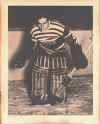
|
Gardiner was
one of the few European-born players to make it to the NHL during
his era. The native of Edinburgh, Scotland, Chuck emigrated to
Canada with his family when he was seven years old. They made
their new home in Winnipeg, Manitoba, one the country's major
hotbeds of hockey.
Gardiner cracked the lineup of the Selkirk Fishermen senior
hockey club in the fall of 1924. His play was inspirational and
he recorded two shutouts to go with a sparkling 1.83
goals-against mark. Gardiner moved up to the Winnipeg Maroons the
next year and became a workhorse, appearing in 74 regular-season
games and eight playoff matches over two years. Once again he'd
met the challenge successfully, posting six shutouts each year
and goals-against averages of 2.16 and 2.14. Most significantly,
he demonstrated that he was a bona fide NHL prospect who didn't
wilt over the course of a long season.
The Chicago Black Hawks had kept a close eye on Gardiner's
development and decided to give him a chance to play in the big
league during their sophomore NHL season in 1927-28. On joining
the Hawks, he was initially slotted to be the understudy to
incumbent Hugh Lehman, but Gardiner quickly won the confidence of
coach Barney Stanley and played the bulk of the games. A major
influence on Gardiner at this time was former scoring star Duke
Keats, who helped him learn to outguess opposing forwards. As a
result, he became one of the toughest netminders to face
one-on-one.
Lehman ended up retiring and taking over the coaching duties when
Stanley retired in mid-season. Gardiner's rookie term was a
personal success as he registered three shutouts and a
respectable 2.85 goals-against average on a team that was
overwhelmed most evenings. He transcended the Black Hawks' woeful
showing in 1928-29 by establishing himself as one of the NHL's
outstanding netminders with five shutouts and a solid 1.85
goals-against record.
Gardiner's hands and feet were lightning quick, as was his mind.
Rarely was he caught unaware on the ice by an opposing shooter.
He was also a fierce competitor who periodically left his net to
thwart an attack or dove into a pile of players to seize the
puck.
Beginning in 1929-30, Gardiner would play a key role in Chicago's
vast improvement. In 1930-31, he recorded a league-high 12
shutouts and a stellar goals-against mark of 1.73. He also earned
his first of three selections to the NHL First All-Star Team. The
following year his netminding heroics brought him the Vezina
Trophy. Gardiner's exceptional play was augmented by his ability
to direct his teammates on the ice, a factor that led to his
being chosen to serve as team captain in 1933-34.
That 1933-34 season was both triumphant and tragic for Chuck
Gardiner. During the regular season, he led the NHL with 10
shutouts en route to his second Vezina Trophy. In the playoffs,
his goal keeping was the backbone of Chicago's first-ever Stanley
Cup championship, over the Red Wings. For the third time in his
career Gardiner topped all playoff goalies in shutouts. A gifted
and durable performer, Gardiner led all NHL goalkeepers by
playing every minute in six consecutive seasons from 1928-29 to
1933-34.
Unfortunately, Gardiner passed away on June 13, 1934, as a result
of a brain hemorrhage. His death, just a few weeks after winning
the Stanley Cup, was one of the most poignant stories of the
NHL's early days. The Wee Scot was considered by his peers to be
among the elite netminders of his time. Many in fact referred to
him as the finest ever at his craft. A member of the Canadian
Sports Hall of Fame, Gardiner was elected to the Hockey Hall of
Fame as a charter member in 1945.
His NHL career stats are as follows:
316 Games played - 112 Wins - 152 Losses, 42 Shutouts, 2.02
Avg.
NHL All-Star 1931, 1932, 1933 and 1934.
Won the Vezina trophy in 1932 and 1934.
The photo on the right hand side was signed by Chuck
Gardiner's wife after his death in 1935.
It says:
To Mildred and Harold "In memory of my husband Chuck
Gardiner",
signed Myrtle Gardiner 1935.
|
| 1934 Walter
"Red" Jackson autographed New York Americans
photo |
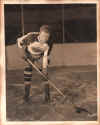 |
Walter Jackson
was a solid left-winger who could check and contribute timely
offence. Most of his NHL playing time took place over a two-year
period with the New York Americans in the early 1930s.
Originally from Instock, England, "Red" Jackson moved to
Winnipeg, Manitoba as a boy. He learned the game in the local
minor hockey system then played senior with the city's CPR,
Elmwoods, and Native Sons teams. He gained his pro experience
after signing on with the St. Louis Flyers of the AHA. Jackson
played most of the 1932-33 season and all of the 1933-34 schedule
with the New York Americans.
Jackson was acquired by the Boston Bruins where he dressed for
two games in 1935-36. He soon found himself back in the minors
after the Bruins transferred his rights to the London Tecumsehs
of the IAHL as compensation for signing Rey Getcliffe. Jackson
later played two years in the AHA before retiring in
1938.
|
| Home | Hockey Autographs - Page 3 |
copyrightę2000-2008
All hockey memorabilia and their images are the exclusive property of the owner and may not be reprinted, copied or used without written permission from the owner. For licensing or other questions please contact hockeybum@proaxis.com
|
 |
|

